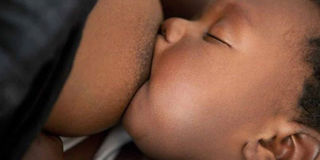How to maintain good hygiene when breastfeeding

Breast milk is the basic food for every baby. Besides being easily digestible, it boosts their immune system, therefore enhancing wellbeing and development. Photo/FILE
What you need to know:
- It is essential that breastfeeding mothers practice good hygiene.
- This includes taking a shower or bath every day and cleaning their breasts and nipples before and after feeding their babies.
- In this article, we explore the best ways in which mothers can take good care of their breasts.
Breast milk is the basic food for every baby. Besides being easily digestible, it boosts their immune system, therefore enhancing wellbeing and development.
Since these toddlers feed through the nipples that are located on the tip of the breasts, it is advisable that every breastfeeding mother observes high levels of personal hygiene.
WHEN BABIES SUCKLE DIRTY BREASTS
Joan Mukiibi Namakula, a midwife , says when mothers do not wash their breasts and nipples properly, they expose their babies to various diseases and infections.
“A dirty breast harbours germs and when an infant suckles it, there are high chances that they will get sick,” Namakula explains.
Some of the common conditions that can result from a child suckling dirty breasts include fever, diarrhoea, vomiting, developing a gaseous abdomen and loss of appetite by the baby.
Dr Alex Kakoraki, a general practitioner, says mothers who do not observe proper hygiene while breastfeeding are likely to emit an awful smell especially if they do not change clothes that have been stained by milk from the breasts.
“Once any kind of breast milk spills on either the bra or blouse, and the breastfeeding mother does not change the clothes, she will immediately start smelling,” he explains.
There is also a tendency for the breasts to become engorged or soggy when the mother does not wear any absorbent material.
“If one does not put on any kind of spongy material to absorb the milk coming from the breasts, it will spill on the bra eventually making it wet. The nipples will even become mushy and sore for the baby to suckle,” Kakoraki explains.
Also, a mother may develop wounds and cracks on the nipples as a result of the continuous poor placement of the breasts on the baby’s mouth.
BEFORE BREASTFEEDING…
Namakula says observing proper breast hygiene is the best way to prevent breastfeeding-related infections. Before any mother goes ahead to breastfeed their baby, Namakula says they should ensure they first wash their hands with clean water and soap.
The baby should also be kept clean at all times, including during breastfeeding.
“The aim of bathing a child before breastfeeding is to ensure that they are comfortable as they suckle. This also ensures that they feed well,” she explains. If the mother does not have enough time, she can only wash the baby’s hands using a clean piece of cloth. This is crucial since babies keep touching the breasts during the process of suckling.
After cleaning the baby, a mother can then put water in a basin and use it for cleaning both her breasts. She could use either a sponge or any piece of cloth for cleaning.
“Make sure you concentrate on the areas beneath the breasts, nipples and areolas while cleaning,” says Namakula. The cleaning can last for about five to 10 minutes. Afterwards, the mother must wipe her breasts using a dry towel and then go ahead to feed the baby.
Mothers should however avoid using any kind of medicated soap or liquid during the cleaning process. This is because one may fail to rinse the nipples properly and when the baby suckles, they could easily get an infection.
DURING BREASTFEEDING
Namakula says that as the child is suckling one breast, the other should be covered so as to avoid milk spilling on the mother’s clothing.
In order to make the breast feeding moment lively, the mother could either talk to the baby or sing. Alternatively, the mother could play with the baby’s feet or hands.
WHAT TO WEAR WHEN BREASTFEEDING
“They should wear breast pads all the time since this can help absorb milk coming from the breasts, and therefore keep a mother’s clothes stain-free,” Namakula explains.
She says the pads can be changed every three hours, depending on how much milk is coming out of the mother’s breasts.
For mothers who cannot afford breast pads, Namakula says they could use small pieces of clothing made out of cotton material, as this can help to absorb the milk.
Namakula further advises mothers to desist from using cotton balls as they can easily peel off. Regarding what sort of clothing is suitable for mothers during breasfeeding, Namakula recommends front-buttoned, zips and V-necks, since they make it easy for the mother to access the breasts. But most importantly, she says nursing mothers should always ensure that they put on the right sizes of bras so that the breasts are kept in a firm position.
This story first appeared in the Daily Monitor




